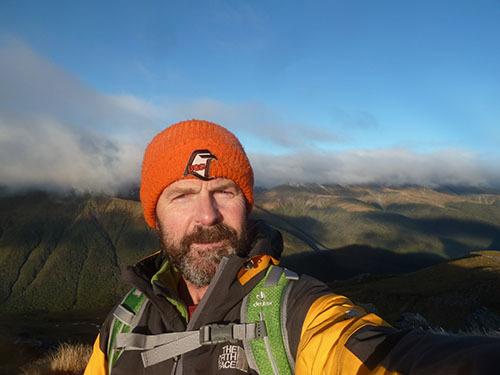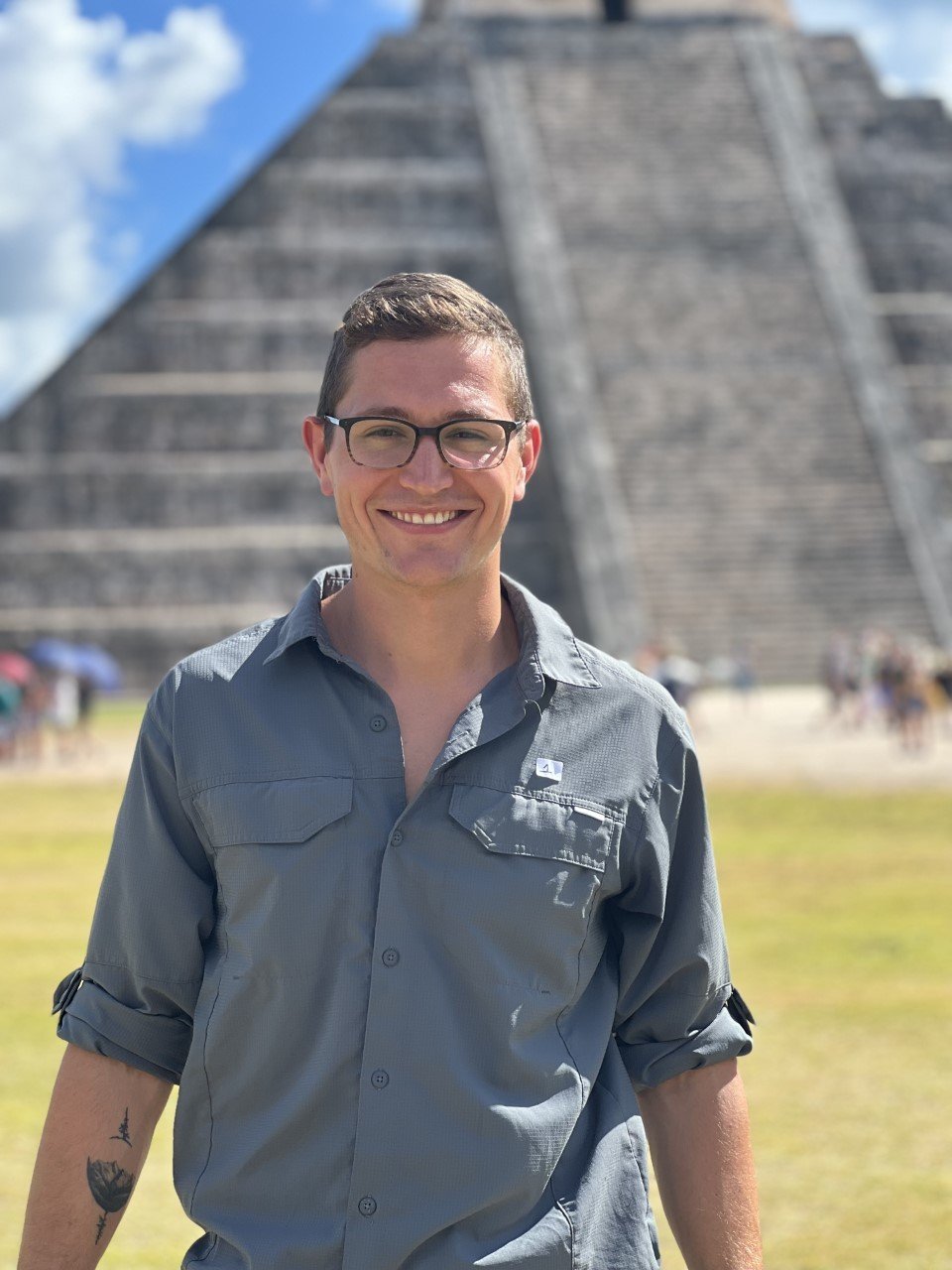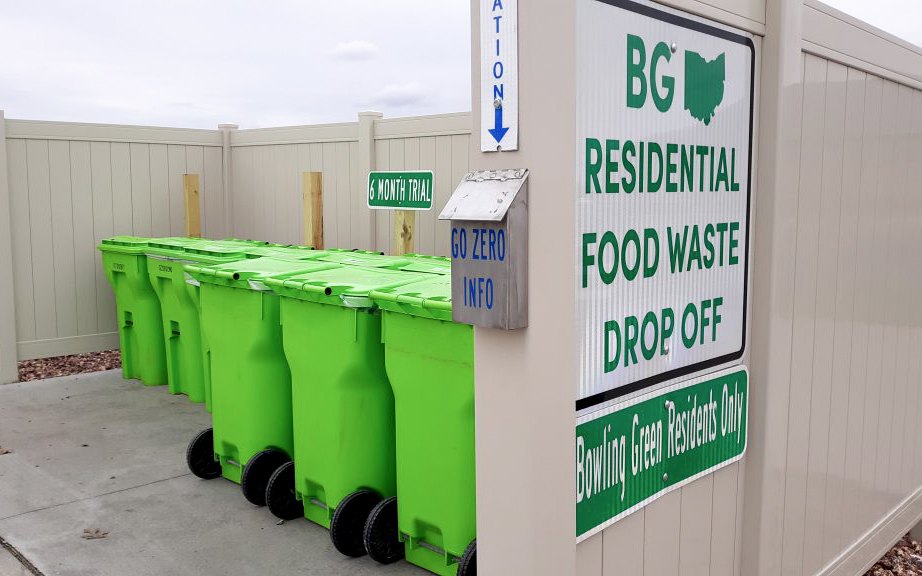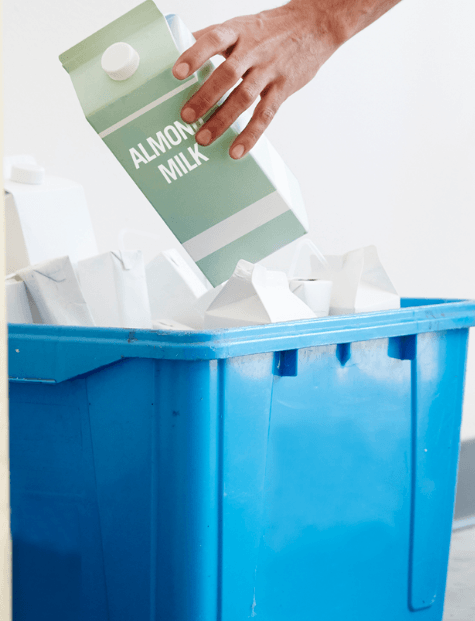Spring 2023 Newsletter
Eco-Hero Spotlight
By: Summer Jordan
The Eco-Hero Spotlight is an initiative started by Campus Sustainability to actively seek out and recognize individuals or groups that make an Eco-friendly impact on BGSU. Anyone can be an Eco-Hero, so long as they are willing to do what it takes to promote sustainability.
In this month's newsletter, our Eco-Hero is BGSU’s Dr. Ian Young.
Dr. Ian Young grew up in Auckland, New Zealand, the country's biggest city, receiving his undergraduate degree in Sociology and Philosophy from the University of Dunedin. From as early as he can remember, he has had an appreciation for nature and the outdoors. After visiting some friends in the United States just before finishing his undergraduate degree, he thought it might be a promising idea to apply to graduate school in the United States. After talking with faculty who shared similar interests and being offered housing and funding to attend BGSU, Dr. Young knew that BGSU would become his new home. He enrolled himself into BGSU in the Fall of 1993, where he’d later earn his PhD in Political Philosophy, Applied Philosophy and Applied Ethics; Dr. Young has been at BGSU ever since. Introduction to Ethics, Environmental Ethics, Philosophy of Death and Dying, Introduction to Peace and Conflict Studies, Modern Political Ideologies, and “Critical Thinking About Great Ideas” (Honors College) are just some of the various courses he teaches at the university, as a teaching professor in the philosophy department here at BGSU.
His early involvement with the Chapman Learning Community started when he was referred by the original director Dr. Thomas Klein, to teach philosophy classes. The Chapman Learning Community features community service work and because of Dr. Young’s strong interest in environmental issues and sustainability, he would reach out to Bowling Green Parks and Recreation to see if they would be open to partnering with the learning community in an effort to bring students opportunities to help refresh and replenish the city around them and this partnership has lasted for 15 years. Every Fall, Dr. Young takes the Chapman Learning Community students to Wintergarden Park where they work with the reservation Naturalist on different restoration projects. He has orchestrated other Chapman learning projects with parks around Bowling Green, such as Simpson Garden Park, Carter Park, and at the sledding hill. Within the last 2 years, the Chapman students have also started to grow their own vegetation in the lab during the winter months which are then moved to the BGSU Community Garden during the spring semester to later supply food for the Falcon Food Pantry.
It is no secret that Dr. Young is passionate about teaching, but he is also no stranger to environmentalism, sustainability, and travel. He has taken students on many educational trips over the years. During the fall semester, he has led a team of scholars as they travel and compete in the Ethics Bowl and during the spring semester, Dr. Young leads the Bioethics Bowl team as they embark on a similar journey. Since 2019, he has taken students overseas to his homeland of New Zealand on a three-week environmental study abroad trip. The first cohort of students who went to study abroad with Dr. Young took part in projects that combined environmental sustainability and environmental art. During this trip, students were able to create sculptures from natural objects and photograph their work. In recent years, students have helped play a part in major restoration projects, partnering with some of faculty from the Zoology and Botany departments from the University of Otago in New Zealand. Students also help with testing the water in streams to determine the health of the body of water and the surrounding ecosystem, as well as collecting Beech Tree seeds from the existing trees to later help aid with rebuilding the Beech Tree Forest. In addition to the service projects, Dr. Young and his students would travel across the south line of New Zealand where they would visit the city of Dunedin in the Otago Peninsula, the Albatross and Penguin colonies who are at risk of extinction, the Ecosanctuary, and even spend a few days with the Māori (indigenous people of New Zealand) learning about their traditions, culture, and attitudes toward the environment.
Campus sustainability looks quite different since Dr. Youngs first arrival on campus. “There was no recycling at all as far as I can remember.” Sustainability at BGSU has become more of a priority and recycling across campus is prominent. The “When You Move Out, Don’t Throw It Out” (WYMO) program, Green Game Day, and the Earth Week tree planting are a few sustainable programs that Dr. Young looks forward to throughout the academic year. If he could bring more sustainable practices to the University, it would be doing away with single use plastic utensils in the dining halls and student union. He also notes that during the summer the bike racks tend to become more cluttered. He believes adding more bike racks around campus and by Shatzel Hall would not only fix this problem but encourage more people to ride their bikes to school and work.
Dr. Young not only practices sustainability at work, but in his personal life. He uses his car as little as possible when commuting to and from campus. Many do not have the luxury of living within walking distance from their job, so he reaps the benefit and walks to work or chooses to ride his bike. In the summer months, Dr. Young looks forward to hang drying his freshly washed clothes outside on a clothesline in his backyard. “Although it takes a bit more time, it’s not bad. the clothes always smell much nicer when you dry them outside.” Some of his other sustainable practices include buying organic foods, shopping locally at the farmers market, and recycling at home.
Dr. Young applauds the work of Dr. Nick Hennessy, Campus Sustainability Manager, for always being so energetic and full of knowledge about sustainability. Dr. Young has watched over the years as Dr. Hennessy has made buildings across campus “greener” than ever; his many efforts to make BGSU’s campus more sustainable do not go unnoticed.
Sharing some advice to future generations interested in the environment, Dr. Young says that “Everything starts with one person. If you take the first steps to model and encourage others to practice sustainability, then that is when we will see a difference made to tackle the environmental issues in the world. Start with the little decisions, shop locally, buy organic, walk as often as possible and ride your bike”.
Thank you, Dr. Ian Young, for being an Eco-Hero and for all that you have done to teach and model sustainability at BGSU.
Where Are They Now?!
By: Summer Jordan
Over the years, many interns have walked in and out of The Office of Campus Sustainability doors. These interns have made major contributions and impacts that have marked successful milestones for the Office of Campus Sustainability. We wanted to know what these interns have been up to and how the work they did as an intern has impacted their lives. Therefore, we started the newsletter series- “Where Are They Now?!”
This February, the Office of Campus Sustainability reconnected with former intern, Adam Smith.
Adam graduated from Bowling Green State University in 2020 with a bachelor's degree in Sociology with a minor in Sustainable Development and Activism.
Campus Sustainability Intern (2017-2020)
Adam worked with Campus Sustainability for most of his undergraduate career at BGSU. After his graduation, Adam married his falcon flame, and they spent a year living out of a van and traveling the states together. Adam met his wife in an Environmental Science course, they have both returned to BGSU to obtain graduate master’s degrees. Adam is now a 2nd year master’s student in the Department of Sociology, working as a part-time Teaching and Research Assistant for the University. Adam’s currently conducting his master’s thesis, and his research is looking at the potential correlates of climate change beliefs. He hopes this study will shed more light on climate change denial within the U.S.
Adam’s journey with the office started when he reached out to Dr. Nick Hennessy about working with Campus Sustainability during his first fall semester at the University in 2017. Adam officially started working for Campus Sustainability during the 2018 Spring semester, primarily working with the Green Fund. Between working with Dr. Nick and serving on the student green fund committee, Adam recalls learning so much about the world of sustainability, “how sustainability works in a large institutions and the barriers of planning and rolling out projects and events was eye opening.” Adam was the student project manager for the propane bus conversion and exterior LED lighting projects. Collectively, these projects made a significant decrease in BGSU’s carbon footprint. Although Adam was not the project manager, he often thinks about his work with EAG (Environmental Action Group) and helping with their proposal to get funding for reusable bags on campus. He admired the activism from EAG as there were lots of pressures put on the Undergraduate Student Government (USG) to get rid of single-use plastic bags across BGSU, “EAG writes this proposal, and it’s like this grass roots organization finally found the solution.;” Adam was happy to approve and fund the EAG reusable bag project as well as witnessing and being a part of the process of educating the student body and getting other departments on board to help the project follow through.
Working at the Campus ReStore was another fun and eye-opening experience for Adam. He often thinks about the amount of waste that BGSU diverts from the landfill as opposed to the other institutions and initiatives by the city of Bowling Green. “Students throw out so much brand-new stuff that people are in need of, so it’s great we have a program like this.” Since working with Dr. Nick, Adam tries to support sustainable practices and be aware of the teachings of environmental sustainability in his life. Adam enjoys gardening, planting and being outdoors, composting and riding his bike everywhere. Even though you must go out of your way sometimes to support sustainable practices, he thinks it is always worth it to make a bigger difference.
Adam’s time with Campus Sustainability was not only educational, but also a fun time. “One thing that I will never forget about working for Dr. Nick is the number of nicknames he made for everyone. During the two years of working for Dr. Nick I don’t think he really called me Adam. He called me AJ, AJ Smitty, Smith. It was funny. He would call me anything but Adam.” Dr. Nick is famous for coming up with nicknames for his Interns; It is one of the many ways that he keeps the office environment fun.
Adam shares some final advice for current BGSU Students and those interested in environmental sustainability, “I think there are so many of us that wish to see many changes both on campus and in our communities. Advocating for these changes is our responsibility, even when it seems like there is very little chance things will change. Persistence, determination, and collaboration are essential to creating sustainable change on campus. My time spent working for Campus Sustainability and serving on the Student Green Initiatives Fund at BGSU taught me this. When it comes to active citizenship and socio-environmental advocacy, I believe that Gandhi said it best, 'Be the change you wish to see in the world'”.
Do you have any special memories of Campus Sustainability interns? Let us know at Greenbg@bgsu.edu.
Comprehensive Compost: No Leftovers Left Behind
By: Zach Hayes
Have you ever thought about what happens to your food once you throw it away? Have you ever wanted to compost but didn’t know where to start? Did you know that the City of Bowling Green offers residential composting?
Food waste is a big problem in our society.
BGSU is no exception as we generate thousands of pounds of food waste weekly. Though not exhaustive, our humble composting initiatives divert between 1,200 and 1,400 pounds of food from the landfill every week. This reduction of waste helps our university stay in line with the Climate Action Plan which calls for a 4% annual reduction in greenhouse gas emissions and reaching zero net carbon emissions by 2040. Food that is buried in a landfill breaks down anaerobically (without the presence of oxygen) to emit methane, a greenhouse gas that’s 25x as heat-trapping as carbon dioxide. You can see how the complete elimination of food waste would make a substantial difference towards reducing further emissions.
To help reduce the amount of food waste being sent to landfills, the City of Bowling Green has also launched a Residential Food Waste Drop Off program through GoZERO Services. Anyone on or off campus who resides in Bowling Green would be welcome to bring their food scraps there to be turned into compost.
You can find the food waste collection site using: 1040 N College Dr, Bowling Green, OH 43402, and then head behind the Public Works garage, near the public Yard Waste Drop Off, on Tarragon Drive.
WHAT'S ACCEPTED?
- Fats & Sugars
- Raw/Cooked Meat
- Bones
- Dairy
- Beans, Eggs,
- Baked Goods,
- Pasta,
- Fruits & Veggies
- Paper Towels & Napkins
- Greasy Pizza Boxes
The EPA (Environmental Protection Agency) estimates that in 2021, up to 150 million tons of food was wasted, which represents 35% of the United States' food supply. We certainly hope that you do not waste edible food, but we also encourage you to begin saving food scraps and leftovers to bring to the BG Food Waste drop-off location. This food waste is a valuable resource for the future of food supply as it generates compost which improves soil quality and food production. Start saving food scraps today! You can even get a lidded 5-gallon composting bucket of your own while supplies last if you are a resident of Bowling Green. Email or call Amanda Gamby, the Sustainability & Public Outreach Coordinator for the City of Bowling Green to schedule your pickup today. Email: agamby@bgohio.org or Call: 419-354-6222.
New to BGSU, Pub 1910 Post-Consumer Composting Pilot!
One way that you can feel good about eating out at BGSU is by frequenting Pub 1910! Beginning in early February, BGSU Dining partnered with Campus Sustainability to begin a post-consumer pilot program. Any leftover foods on diner’s plates are taken by restaurant staff, discarded in a dedicated receptacle, and collected every few days by Campus Sustainability staff. This collaboration with BGSU Dining Services has been a huge success and resulted in the additional composting of more than 300lbs of food waste in its 1st month. Thank you, Pub 1910 staff!
You don't live on-campus? Try making your own compost at home!
WishCycling at BGSU
By: Dr. Nicholas Hennessy
Wishcycling is putting something in the recycling bin that is not recyclable and hoping it will be recycled. Common items that people wish-cycle are things you would expect can be recycled. Some items may have a recycling symbol on it but may not be recyclable in your area.
You walk up to a recycling bin with something you want to recycle and you’re pressed for time. You have the option of putting something in the trash, or in the recycling bin. You see the signage and you item is not listed, but you’re pretty sure your item can be recycled, or at least you really want it to be recycled. You figure that even if it’s not recyclable, that somehow, some way, someone else will eventually remove it, so no harm/no foul. Right? Well, not really. The reality is that contamination (things that are not recyclable at BGSU), placed into otherwise uncontaminated recycling can result in an entire truck load of recycling being taken to the landfill rather than it being recycled, since that load will be rejected at our sorting facility in Southfield, Michigan. This ends up being a loss for the environment, as well as a financial loss for BGSU, as we pay for the load to be taken to our sorting facility and then pay again to have it taken to the landfill.
The phenomenon of people putting items into recycling that are not recyclable, even when that person knows the items are likely not recyclable is referred to as “wishcycling” or “aspirational recycling”. It refers to the thought that the person really “wishes” that the item was recyclable, even if that item is clearly listed on our signage as not recyclable. It’s something that has been the subject of much research nationwide, results in tremendous losses of recyclable materials to the landfill and is also the topic of an Ohio EPA grant currently being administered by Dr. Donna Trautman, Associate Professor of Visual Communication Technology and Dr. Nick Hennessy, BGSU Sustainability Manager. The grant was awarded by the Ohio Environmental Protection Agency, Recycling and Litter Prevention Program in the spring of 2022. It involves a comprehensive approach to recycling contamination education, combining the efforts of Visual Communication Technology classes at BGSU and Campus Sustainability to address recurring contamination issues. Through the creation of a wide variety of educational pieces that will be deployed across campus, the ultimate goal is to change the culture of wishcycling and ultimately, the behavior of those engaging in our recycling program.
How is this being done? Since many of those using the recycling system at BGSU are students, it makes sense to have students involved in creating things like signage, social media campaigns, educational videos and other means of educating their peers about the right way to recycle. The results so far after contributions from students in Dr. Trautman’s VCT 4800 classes (Sustainability in VCT) have been phenomenal. Effective, engaging, entertaining, and sometimes downright funny are some of the ways to describe the work product created by students thus far. The Ohio E.P.A. agreed that BGSU is in a unique position to get to the root of the contamination issue; why it’s happening, as well as what would change the behavior of people. After all, not many institutions have the benefit of having administered a recycling program for multiple decades, as well as 18,000 students, plus faculty and staff to participate in the program. So our “laboratory” for experimenting with new ways to change how people view and engage in recycling is huge. Part of the grant includes sharing examples of our results such as print media, filmography, photography and other forms of VCT with other schools and institutions in the state to assist them with what is certainly a common problem in recycling programs.
Be on the lookout soon for some of these innovative and new ways of helping people to understand and see what is recyclable and what is not which will hopefully eliminate much of the recycling “wishes” that have been contributing to our contamination problem.
Sustainability Questions & Suggestions
Do you have any questions, comments, concerns, or suggestions related to sustainability? If so, feel free to contact us at greenbg@bgsu.edu. Alternatively, you can reach us on Facebook, Twitter, or Instagram @GreenBGSU.
We look forward to hearing from you!
Like staying up to date on all of BGSU's sustainability updates? Be sure to subscribe to our newsletter to get it sent to your email inbox each month!
Updated: 01/19/2024 01:02PM




